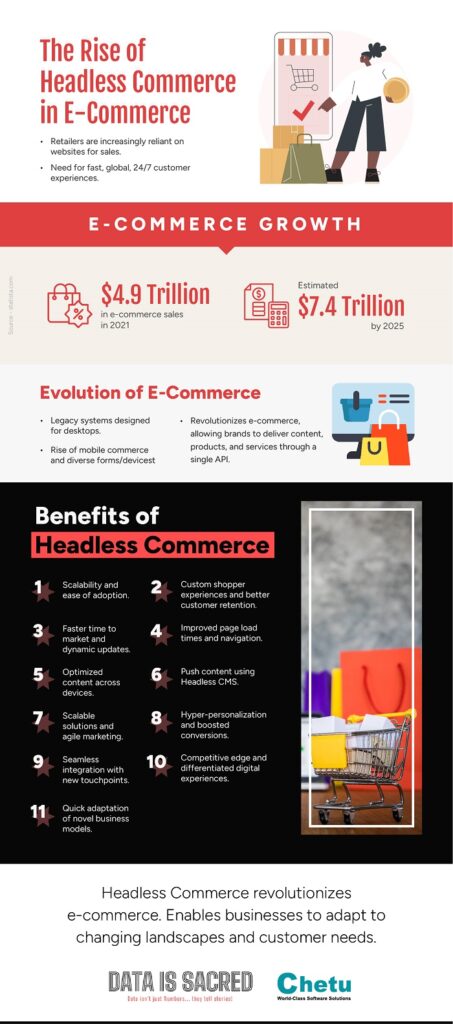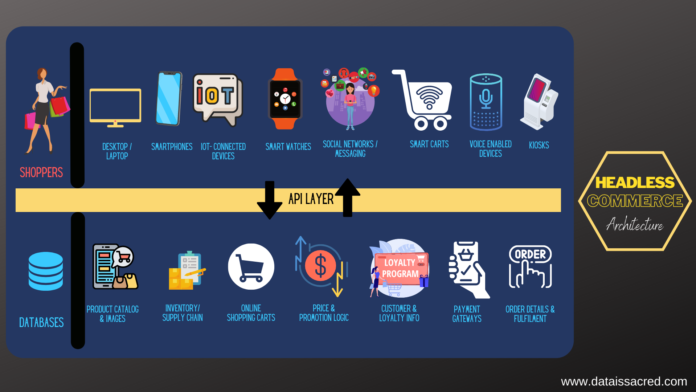HEADLESS COMMERCE BENEFITS:
With the rise in e-commerce, retailers are becoming increasingly dependent on their websites for sales.
These sites must offer a wonderful experience with fast load times and easy content management as they try to keep up with customers worldwide 24 x 7! This is where Headless Commerce comes into the picture- a topic that I will cover in detail over this blog post.
According to Statista.com, in 2021, retail e-commerce sales amounted to approximately $4.9 trillion worldwide. This figure is estimated to grow by 50 percent, reaching about $7.4 trillion by 2025.
Nowadays, online transactions happen across a rising number of platforms and devices — from laptops, smartphones to Connected devices and IoT. Yet, many of today’s e-commerce infrastructure is a legacy of the past and were designed primarily for desktops. Legacy applications’ architectures were huge, using tightly coupled backend and frontend components with low flexibility and long time to market.
Over the past decade, mobile commerce, and the emergence of various other forms of e-commerce have stepped up the demand for more flexible e-commerce solutions. One buzzword that is so central to this complete reimagination of commerce on the digital shelf is ‘Headless Commerce.’ Headless Commerce refers to the process of splitting or decoupling eCommerce or online retail storefronts (“head”) from their backend/commerce functions (“the body”). An API (application programming interface) layer connects headless commerce architecture’s backend and frontend components. A Headless commerce API enables eCommerce brands to deliver content, products, and payment services through a single API.

Infographic Source – Chetu | Link – https://www.chetu.com/retail/e-commerce.php
By enabling brands and retailers to use emerging e-commerce mediums like voice, text, and mobile, this approach allows them to easily tap into emerging customer interactions such as social selling, message-based sales channels, and quick checkouts. Of course, we know about headless architecture pioneers like Amazon who offers seamless online shopping experiences across desktop, mobile, and voice.
Due to their independence from the backend system can also create compelling experiences for customers with smartwatches and kiosks without knowing how they work! Application Programming Interface (APIs) enable output delivery such as brand artifacts, videos, images, product details, pricing, and “buy it now” options – to frontend experiences. It also includes any digital user interface (UI) – such as app-based transactions, Instagram stores, or interactive kiosks. These APIs function as software intermediaries and allow two applications to talk to and rapidly deliver solid solutions.
Unleashing Digital Transformation with Offshore Development Centers
It is worth noting that, Offshore development centers accelerate mobile app innovation by seamlessly integrating AI and ML for personalized experiences, streamlined operations, and data-driven insights.
COMPONENTS OF A HEADLESS COMMERCE ARCHITECTURE:
As a result of headless commerce, businesses can architect their customer experiences and commerce systems faster than ever before.
Headless Commerce, however, is not only a paradigm shift; it is a revolution. By using it, merchants can develop online stores without building their storefronts. Developers can build coordinated, brand-consistent experiences across channels using e-commerce platforms with speed, scale, tool usability, APIs, and integrations with third-party tools. Design and UX teams can prioritize enhancing the customer experience and interface to increase conversions, while technical teams optimize the user experience and interface.
Headless Commerce Benefits:
The benefits of Headless Commerce are worth the effort and make your business scalable and adaptive to changing eCommerce landscape.
1. Scalable modern eCommerce platform: Headless commerce leads to higher adoption as the learning curve is low. Developers and technical team members can easily view and update the front end without requiring advanced knowledge and skill set. Also, with headless commerce templates and vendor solutions, tech developers only need a few clicks or basic coding to jumpstart commerce apps that increase engagement and conversion.
2. Right tools for better CX: Creating a custom shopper experience with headless commerce is one of the key benefits. Ensure that APIs incorporate promotions, inventory, product information, and other common commerce services to assure coordinated, brand-consistent experiences across channels. Having more control over all the elements users interact with on their website allows brands to publish more creative content on their sites. By boosting the customer experience (CX), brands and retailers can attract and retain more customers.
3. Faster Time to Market: Businesses can easily create new front-end experiences with headless commerce. With a minimum of backend development and associated cost, a company can react quickly to a new market trend. Agile development saves developers time.
4. Dynamic updates: when a business introduces updated content to its front end, those updates are reflected instantly. Typically, sites built with traditional commerce components sometimes take minutes, hours, or even days before customers can experience a brand’s latest design or content.
5. Improved page load timing and navigation: With headless commerce, merchants can leverage advanced web applications (PWAs), which increase page load speed, which in turn lowers abandonment rates.
6. Optimized content across devices and platforms: Platforms that allow for headless commerce make the same information available and optimize it for multiple platforms and contexts. Headless commerce is particularly beneficial to the fast-growing mobile commerce channel. As long as a traditional commerce architecture was developed for desktop navigation, it will typically display the same layout on a smartphone and laptop, so potential shoppers will need to zoom in to read content, or they will have difficulty finding the “Add to Cart” button, or they will abandon their cart. Retailers can cater to various devices and conditions by creating specific experiences for different mediums without updating the backend components. This improves glance views, conversions, and sales.
7. Push content anywhere using Headless CMS: In an eCommerce context, this means providing product content, images, product videos, or blog posts from every channel – present or future!
8. Scalable Solutions: With a traditional eCommerce platform, you will have difficulty moving from concept to market and scaling. On the other hand, a headless commerce platform allows brands to develop better frontend experiences across multiple devices and touchpoints and deliver via API. Adopting new channels, entering new regions, etc., the time to market is shortened.
9. Facilitates Agile Marketing: A headless commerce system is scalable and supports new technology as it emerges, so it is ideal for agile marketing. Various customer experiences can be designed using it. This puts marketing teams in charge of rolling out multiple sites across multiple brands, divisions, and portfolios.
10. Hyper-personalization: Online brands must understand the needs of their customers across all channels. An affinity analysis and market basket analysis are much further than “people who bought x also bought y.”. The backend powers the personalization engines in CMS, mobile apps, and social channels using the consumer’s purchase history. Removing data silos between touchpoints allows brands and retailers to better utilize predictive analytics by making customer data more accessible and actionable.
11. Boost Conversions: A/B testing helps optimize conversions with headless commerce. One such example is the experimental comparisons of the performances of different backend search solutions vis-à-vis existing frontend search solutions. It allows you to continuously test and optimize your site to understand your customers better while improving your learning rate faster than most competitors.
12. Seamless Integration to new digital touchpoints: A headless commerce platform integrates and communicates with other platforms via APIs, extending commerce capabilities to new touchpoints and enhancing seamless integration. Consumers today can shop on social media pages, smartwatches, connected cars, and much more – and each of these platforms requires a slightly different approach but can also offer better customer service and convenience. They are enabling voice commerce, Social Selling, and Connected Devices.
13. Competitive Edge: Headless commerce platforms allow quick updates without affecting your backend systems. Furthermore, you can easily adjust your front end without experiencing outages or downtime. With a headless commerce system, you only have to update parts of the system, reduce downtime and deliver services to consumers as soon as possible. This is a significant competitive advantage when other retailers struggle to manage their inflexible, legacy monolithic platforms.
14. Differentiated digital experience: In the post-pandemic era, the need for a differentiated digital experience is increasingly critical to lure customers online. Creating engaging digital experiences is easy for merchants with headless commerce architecture’s modular nature.
15. Quick adaptation of novel business models: Subscriptions, rentals, and other trending approaches to commerce can be enabled by modules instead of updating an e-commerce site’s entire backend infrastructure.


